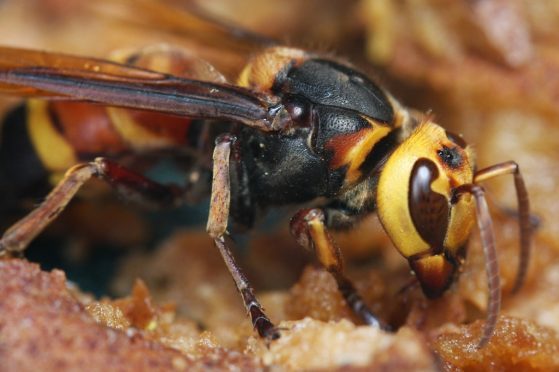Pest experts are urging residents in Aberdeen to be vigilant following the first sighting of an Asian hornet in the UK.
The invasive species that preys on honey bees was spotted in Tetbury, Gloucestershire earlier this week and attempts are underway to find and destroy its nests.
But the British Pest Control Association (BPCA) says confirmed sightings in both the Channel Islands and now mainland Britain mean that many more are likely to be found and the national trade body calling on people who discover them to act responsibly.
The hornet, said to pose a very real threat to our native species of bees, is already common across Europe and officials anticipating its arrival in this country for several years have set up a protocol designed to eradicate them.
Simon Forrester, chief executive of the BPCA, said: “Professional pest controllers have been aware of the threat posed by Asian hornets, alongside other invasive species, for some time.
“The BPCA and its members form the first alert to these threats and are often called in to deal with such pests.
“The first sighting will almost certainly not be the last, but if people report them sensibly then major problems can be avoided.
“Our members will do everything they can to maintain the health of our honey bee population and can be called upon to deal sensitively with any situation that arises.”
The Department for Environment, Food and Rural Affairs (DEFRA) has set up a three-mile surveillance zone and a ‘species alert’ has been issued.
Nicola Spence, Defra’s deputy director for plant and bee health, said: “We have been anticipating the arrival of the Asian hornet for some years and have a well-established protocol in place to eradicate them and control any potential spread.
“It’s important to remember they pose no greater risk to human health than a bee, though we recognise the damage they can cause to honeybee colonies. That’s why we are taking swift and robust action to identify and destroy any nests.”
The distinctive hornet, smaller than the native species, is most likely to be found in southern parts of England, but could also be accidentally imported among goods such as soil with pot plants, cut flowers, fruit and timber.
It’s active months are between April and November though its inactive over the winter.
Sightings should be sent with a photograph and local details to alertnonnative@ceh.ac.uk
What does it look like?
- Distinctive hornet, smaller than our native European Hornet species.
- A key feature is the almost entirely dark abdomen, except for the 4th segment which is yellow.
- Bright yellow tips to legs (native hornet dark)
- Entirely brown or black thorax (native hornet more orange)
- Workers can be up to 25mm in length.
